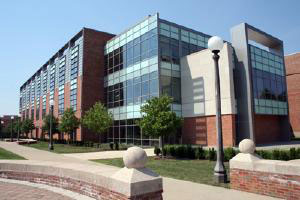| Sep 05, 2008 |
Expanded Micro and Nanotechnology Laboratory at University of Illinois dedicated
|
|
(Nanowerk News) On Thursday, September 4, the University of Illinois' hosted Capital Development Board Chairman Anthony Licata and other state officials on campus dedicated the recently expanded Micro and Nanotechnology Laboratory (MNTL). The dedication ceremony celebrates the completion of an $18 million, state-funded expansion of one of the nation's premier and largest research laboratories in academia for micro and nanoelectronics, nanophotonics and optoelectronics, nanomedicine and bionanotechnology, and MEMS/NEMS and integrated systems research. The expansion added new lab, research, classroom and meeting space.
|
 |
|
"This dedication is about more than cutting a ribbon," stated Ilesanmi Adesida, dean of the College of Engineering. "It is an affirmation of the University's continued leadership in the ever-expanding field of nanotechnology, as well as the State's support of these efforts. What we are researching now will impact our society and planet for decades to come, and play ubiquitous role in maintaining our nation's global competitiveness." Adesida, whose own research is among the pioneering efforts in semiconductor fabrication at the nanoscale, is also the director of Center for Nanoscale Science & Technology (CNST), and the previous director of the MNTL.
|
|
"The expansion of the laboratory, evolving out of the National Science Foundation-funded Center for Compound Semiconductor Microelectronics, makes it the par excellence university-based facility for semiconductor, nanotechnology, and biotechnology research," said MNTL Director Rashid Bashir, a Bliss Professor of Electrical and Computer Engineering and Bioengineering, whose own research involves developing nanotechnology-based solutions to address biomedical problems. "At MNTL, we have a rich tradition of innovation, excellence, and leadership evidenced through the research and development of many paradigm-shifting and revolutionary innovations in the area of semiconductors, III-V, including light-emitting diode (LED), laser transistors, plasma display, and many others."
|
|
Already considered one of one of the world's most advanced centers of nanotechnology, the University of Illinois at Urbana-Champaign was ranked among the top three academic institutions in nanotechnology research, education, and facilities by Small Times magazine in 2007. Illinois' global leadership position in nanotechnology is built in part on the diversity of the state's research and commercial applications for nanotech products in electronics, medicine, agriculture. and information technology. As nanotechnology becomes a high priority for private, state and federal investment, Illinois universities are responding by formulating plans for expanded nanoscale research. Illinois will continue to partner with the public and private sector to create, grow, and retain technology companies as we continue to help them develop innovative programs.
|
|
Researchers at MNTL are pushing the frontiers in many aspects of nanotechnology including:
|
|
Nanofabrication – The design and manufacture of devices with dimensions measured in nanometers. One nanometer is a millionth of a millimeter. Nanofabrication is of interest to computer engineers because it opens the door to super-high-density microprocessors and memory chips.
|
|
Nanocharacterization – The design and use of instruments required for nanotechnology research and the manipulation of the tiny elements involved.
|
|
Nanophotonic crystals – Synthetically manufactured crystals with special electronic and magnetic properties that have a wide range of uses.
|
|
Nanobiosensors – Tiny sensors that replicate human senses, such as smell, can be used to locate and identify specific conditions at a molecular level; with applications in national security, agriculture, and food industries.
|
|
The MNTL dedication was held in conjunction with the University of Illinois CNST Nanotechnology Workshop 2008, on September 4-5, at the Beckman Institute and the MNTL. Established in 2001, the CNST is located in the new building and leads the way to foster multidisciplinary research, education, and entrepreneurship in nanotechnology on the University of Illinois campus and beyond. Arden Bement Jr., director of the National Science Foundation, and Robert Leheny, deputy director of the Defense Advanced Research Projects Agency, will be keynote speakers at the annual Nanotechnology Workshop.
|
|
As part of the building dedication, artwork in the building's atrium will be unveiled. The piece, entitled, "Light Array Rhythm Catcher" by S. Thomas Scarff, was inspired by light emitting diode (LED) technology advanced at the University of Illinois.
|
|
Illinois has a strong track record of investing in research and development infrastructure that supports all of the high technology sectors. The Illinois Department of Commerce and Economic Opportunity (DCEO) has committed more than $238 million to support world-class research and development facilities, and $79 million to support the development and construction of research and technology parks and incubators in Illinois. DCEO has administered more than $40 million in grants to support the emerging field of nanotechnology.
|

